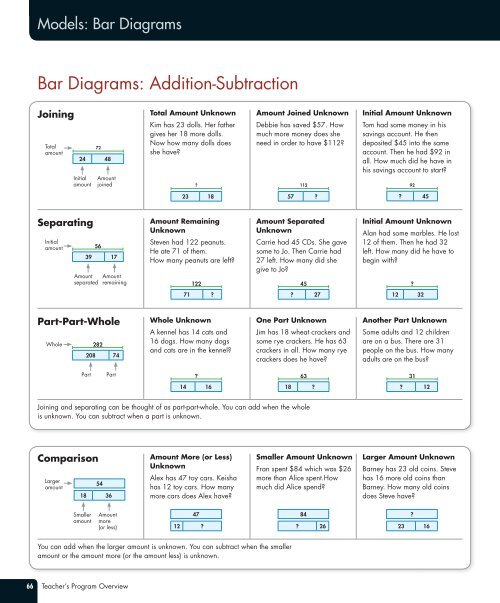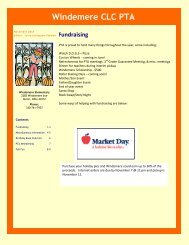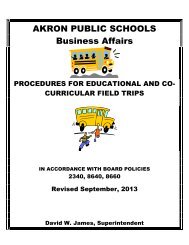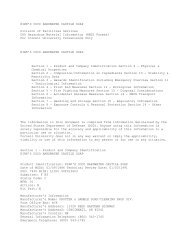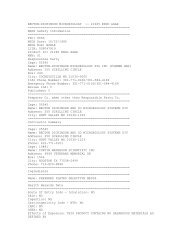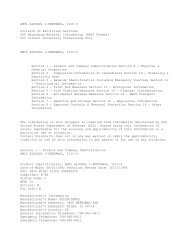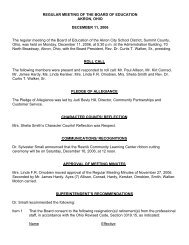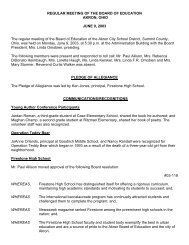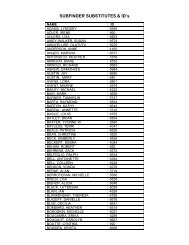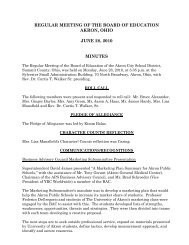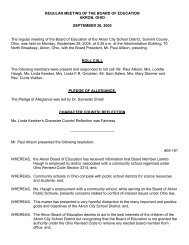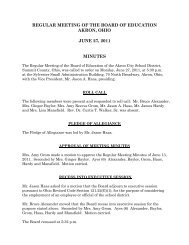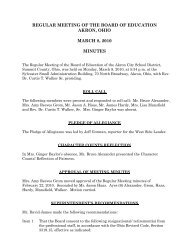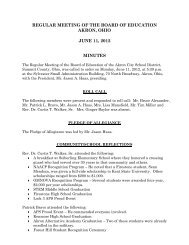Bar Diagrams: Addition-Subtraction - Akron Public Schools
Bar Diagrams: Addition-Subtraction - Akron Public Schools
Bar Diagrams: Addition-Subtraction - Akron Public Schools
Create successful ePaper yourself
Turn your PDF publications into a flip-book with our unique Google optimized e-Paper software.
Models: <strong>Bar</strong> <strong>Diagrams</strong><br />
<strong>Bar</strong> <strong>Diagrams</strong>: <strong>Addition</strong>-<strong>Subtraction</strong><br />
Joining<br />
Total<br />
amount<br />
72<br />
24 48<br />
Initial<br />
amount<br />
Total Amount Unknown<br />
Kim has 23 dolls. Her father<br />
gives her 18 more dolls.<br />
Now how many dolls does<br />
she have?<br />
Amount<br />
joined ?<br />
23 18<br />
Amount Joined Unknown<br />
Debbie has saved $57. How<br />
much more money does she<br />
need in order to have $112?<br />
112<br />
57 ?<br />
Initial Amount Unknown<br />
Tom had some money in his<br />
savings account. He then<br />
deposited $45 into the same<br />
account. Then he had $92 in<br />
all. How much did he have in<br />
his savings account to start?<br />
92<br />
? 45<br />
Separating<br />
Initial<br />
amount<br />
56<br />
39 17<br />
Amount<br />
separated<br />
Amount Remaining<br />
Unknown<br />
Steven had 122 peanuts.<br />
He ate 71 of them.<br />
How many peanuts are left?<br />
Amount<br />
remaining 122<br />
71 ?<br />
Amount Separated<br />
Unknown<br />
Carrie had 45 CDs. She gave<br />
some to Jo. Then Carrie had<br />
27 left. How many did she<br />
give to Jo?<br />
45<br />
? 27<br />
Initial Amount Unknown<br />
Alan had some marbles. He lost<br />
12 of them. Then he had 32<br />
left. How many did he have to<br />
begin with?<br />
?<br />
12 32<br />
Part-Part-Whole<br />
Whole<br />
282<br />
208 74<br />
Whole Unknown<br />
A kennel has 14 cats and<br />
16 dogs. How many dogs<br />
and cats are in the kennel?<br />
One Part Unknown<br />
Jim has 18 wheat crackers and<br />
some rye crackers. He has 63<br />
crackers in all. How many rye<br />
crackers does he have?<br />
Another Part Unknown<br />
Some adults and 12 children<br />
are on a bus. There are 31<br />
people on the bus. How many<br />
adults are on the bus?<br />
Part Part ?<br />
14 16<br />
63<br />
18 ?<br />
31<br />
? 12<br />
Joining and separating can be thought of as part-part-whole. You can add when the whole<br />
is unknown. You can subtract when a part is unknown.<br />
Comparison<br />
Larger<br />
amount<br />
54<br />
18 36<br />
Amount More (or Less)<br />
Unknown<br />
Alex has 47 toy cars. Keisha<br />
has 12 toy cars. How many<br />
more cars does Alex have?<br />
Smaller Amount Unknown<br />
Fran spent $84 which was $26<br />
more than Alice spent.How<br />
much did Alice spend?<br />
Larger Amount Unknown<br />
<strong>Bar</strong>ney has 23 old coins. Steve<br />
has 16 more old coins than<br />
<strong>Bar</strong>ney. How many old coins<br />
does Steve have?<br />
Smaller<br />
amount<br />
Amount<br />
more<br />
(or less)<br />
47<br />
12 ?<br />
84<br />
? 26<br />
?<br />
23 16<br />
You can add when the larger amount is unknown. You can subtract when the smaller<br />
amount or the amount more (or the amount less) is unknown.<br />
66<br />
Teacher’s Program Overview
<strong>Bar</strong> <strong>Diagrams</strong>: Multiplication-Division<br />
Joining<br />
Equal Groups<br />
Total<br />
Number<br />
of groups<br />
84<br />
28 28 28<br />
Total Amount Unknown<br />
Kim has 4 photo albums.<br />
Each album has 85 pictures.<br />
How many photos are in her<br />
4 albums?<br />
Amount Per Group<br />
Unknown<br />
Pam put the same number of<br />
apples in each of 4 bags. She<br />
ended up with 52 apples in<br />
bags. How many apples did<br />
she put in each bag?<br />
Number of Groups<br />
Unknown<br />
Fred bought some books.<br />
Each book cost $16. He spent<br />
$80 on books. How many<br />
books did he buy?<br />
Amount<br />
per group<br />
?<br />
85 85 85 85<br />
52<br />
? ? ? ?<br />
80<br />
16 ?<br />
Separating<br />
Equal Groups<br />
Total<br />
Number<br />
of groups<br />
138<br />
46 46 46<br />
Amount<br />
per group<br />
Amount Per Group<br />
Unknown<br />
Bryan got 45 pigeons. He put<br />
them in 5 pens with the same<br />
number of pigeons in each pen.<br />
How many pigeons are in<br />
each pen?<br />
45<br />
? ? ? ? ?<br />
Number of Groups<br />
Unknown<br />
A total of 108 children signed<br />
up for soccer. The coach put<br />
them into 18-person teams.<br />
How many teams were made?<br />
108<br />
18 ?<br />
Total Amount Unknown<br />
Kim had some cards. She put<br />
them into piles of 35 and was<br />
able to make 4 piles. How<br />
many cards did she start with?<br />
?<br />
35 35 35 35<br />
Joining or separating equal groups is like part-part-whole. You can multiply when a whole (total) is unknown.<br />
You can divide when the number of equal parts (groups) or the size of each part group is unknown.<br />
Comparison<br />
Larger<br />
amount<br />
Smaller<br />
amount<br />
78<br />
26 26 26<br />
26<br />
3 times<br />
as many<br />
Larger Amount Unknown<br />
Alex has 17 toy cars, Keisha<br />
has 3 times as many. How<br />
many cars does Keisha have?<br />
?<br />
Smaller Amount Unknown<br />
<strong>Bar</strong>ney has 24 old coins.<br />
This is 3 times as many coins<br />
as Steve has. How many<br />
old coins does Steve have?<br />
24<br />
Number of Times as<br />
Many Unknown<br />
Ann’s teacher is 39 years old.<br />
Ann is 13 years old. Ann’s<br />
teacher is how many times as<br />
old as Ann?<br />
39<br />
17 17 17 3 times<br />
as many<br />
? ? ?<br />
3 times<br />
as many<br />
13<br />
? ? times<br />
as many<br />
17<br />
?<br />
13<br />
You can multiply when the larger amount is unknown. You can divide when the smaller<br />
amount or the number of times as many is unknown.<br />
• Focused instruction on bar diagrams is in problem-solving lessons,<br />
in lessons on meanings of operations, and in lessons on mental math.<br />
• A variety of problems as shown here are infused in lessons to help<br />
students develop the quantitative reasoning needed for success on highstakes<br />
tests and in real life.<br />
Program Guide 67


